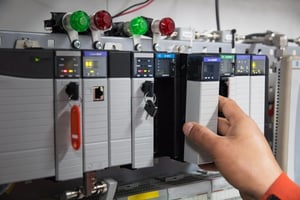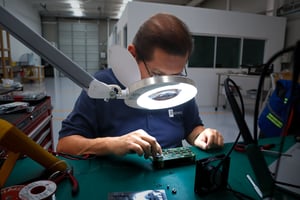The product lifecycle of a technical system is often longer in practise than the availability of spare parts. Every day, manufacturers worldwide are discontinuing products, so their end of life is announced. This affects not only the systems manufacturer but largely the operator of the plant. The machine down risk for a defective component within the system increases. While it was common practise a few years ago to stock critical components, it was soon removed in respect of warehouse costs and the tied-up capital and replaced by just-in-time inventory availability by the manufactures or distributors.
 This displacement is a strategic decision from an economic point of view if the equipment has been newly procured and the manufacturer has a long-term assurance of spare parts. However, if the existing facilities are already older, this economic decision must be reconsidered. It must be weighed here between downtime = shut down / downtime costs vs. Warehousing & spare parts costs. Followed by the question through which sources can obsolete articles still be procured. You should also consider options such as repairs as well as technically tested used items or surplus. This process is classically attributed to reactive obsolescence management.
This displacement is a strategic decision from an economic point of view if the equipment has been newly procured and the manufacturer has a long-term assurance of spare parts. However, if the existing facilities are already older, this economic decision must be reconsidered. It must be weighed here between downtime = shut down / downtime costs vs. Warehousing & spare parts costs. Followed by the question through which sources can obsolete articles still be procured. You should also consider options such as repairs as well as technically tested used items or surplus. This process is classically attributed to reactive obsolescence management.
The OM is divided into 3 levels:
• Reactive OM
• Proactive OM
• Strategic OM
Reactive obsolescence management

In reactive obsolescence management, as the name implies, solutions to already existing failures due to obsolete components are being discussed. Once the failure took place, it is tried to source the defective part through various sources. If the same component has already failed repeatedly, you usually stock this component. The decision is reactionary based on a Case by Case basis. However, the basic risk of subsequent failures is neglected and no long-term, proactive, measure are created to handle obsolescence cases.
Proactive Obsolescence Management
Preventive obsolescence management, unlike Reactive OM, deals with the analysis of individual components within each System /machine. Critical components are monitored based on their product life cycle. This allows an early response to possible obsolescence cases. Maintenance can procure critical components, assemblies and components early for stockpiling or deal with retrofitting the equipment. From a business point of view, costs can be reduced through early storage. As longer downtime is avoided. Or investment plans can also be generated to update, upgrade or disassemble individual machines. Proactive OM does not necessarily have to be in-house. External service providers can be used who take over this monitoring process. Radwell International offers you an analysis of your machinery park.








